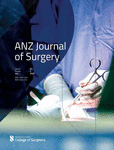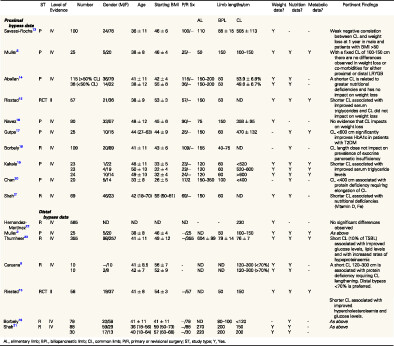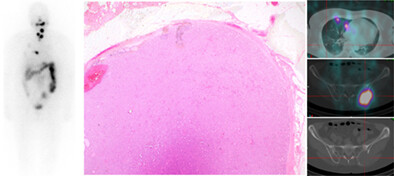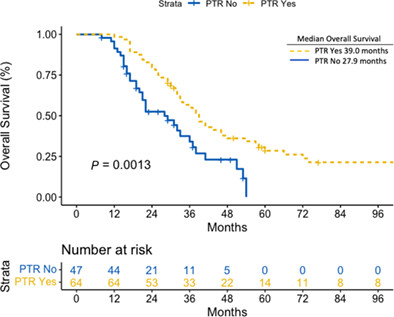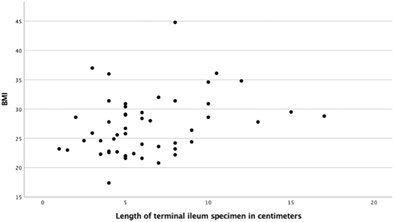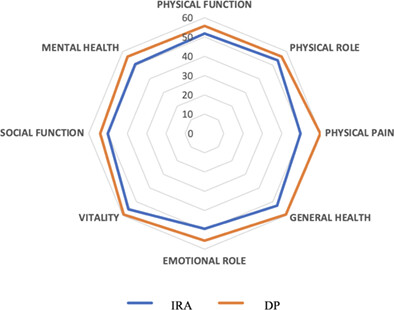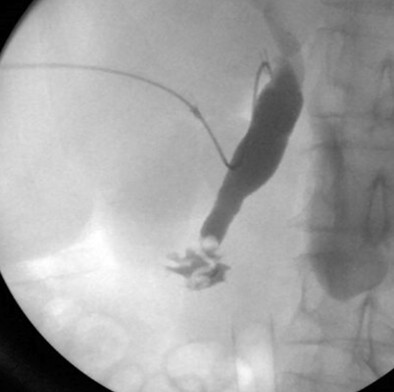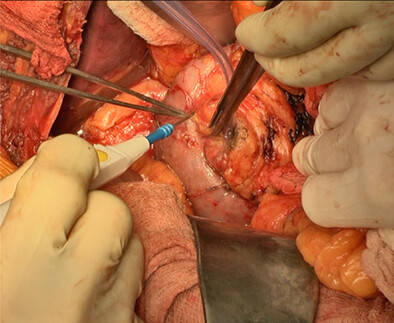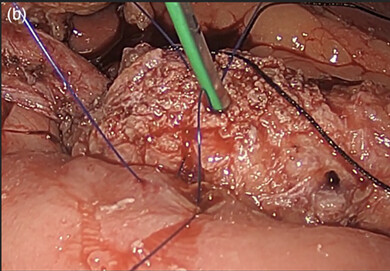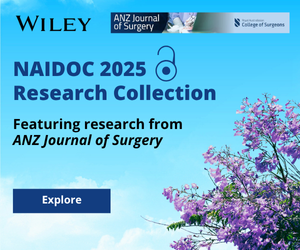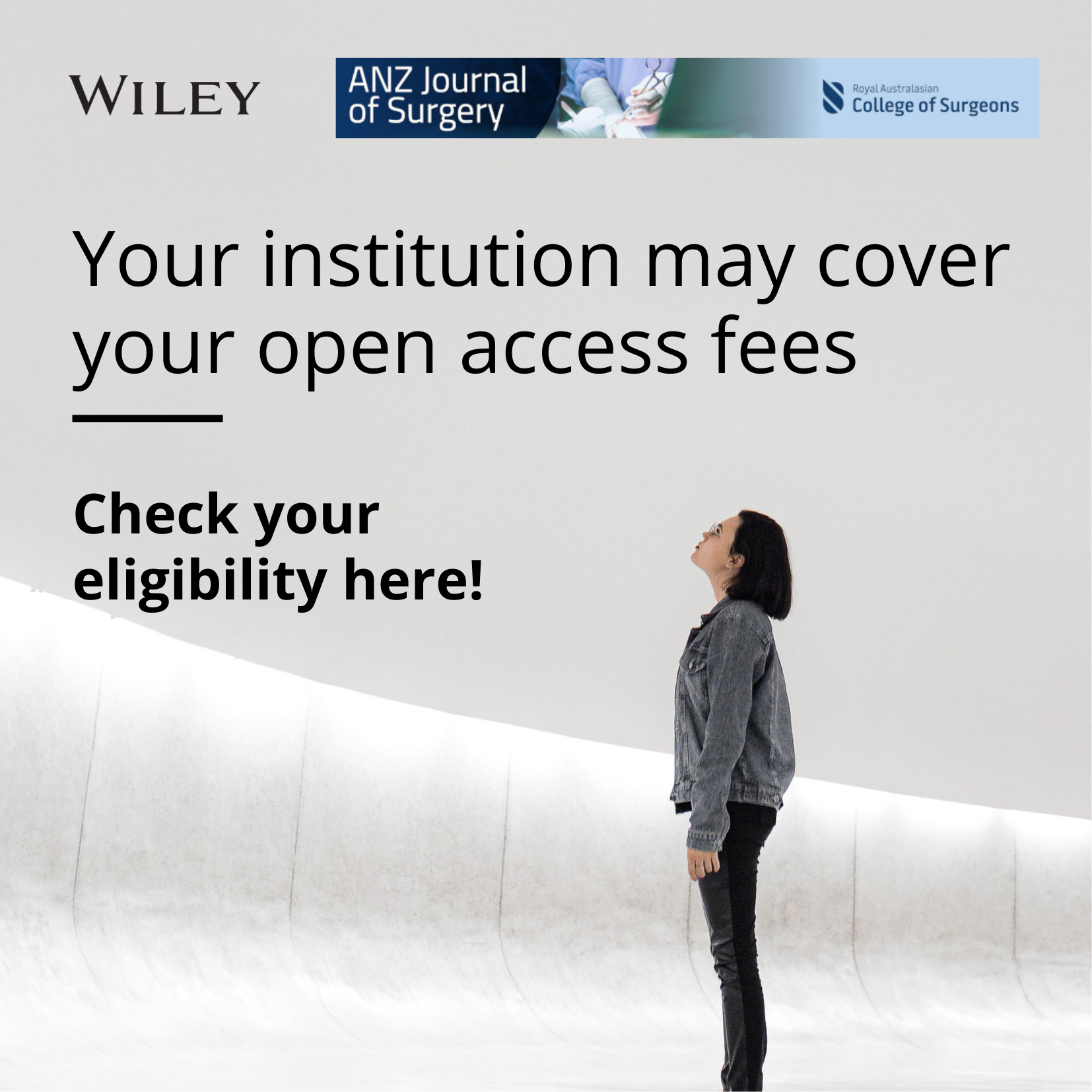Journal list menu
Export Citations
Download PDFs
ISSUE INFORMATION
EDITORIALS
Surgical management of injured Australian Defence Force personnel in Afghanistan: what can we learn?
- Pages: 800-801
- First Published: 13 April 2023
Catchy code names in trauma care cannot replace surgical decision-making
- Pages: 802-803
- First Published: 13 April 2023
ORATION
PERSPECTIVES
Self-discharge as a marker of surgical cultural competency and cultural safety for Aboriginal and/or Torres Strait Islander patients
- Pages: 807-809
- First Published: 29 December 2022
Elective surgery after COVID19 infection: long exclusion times may not be justified in a highly vaccinated population and milder strains of the virus
- Pages: 810-811
- First Published: 28 February 2023
Intermittent pneumatic compression devices: time to reassess the evidence
- Pages: 812-814
- First Published: 27 February 2023
Direct oral anticoagulants for venous thromboembolism prophylaxis in orthopaedic trauma: a clear first choice?
- Pages: 815-816
- First Published: 02 February 2023
Towards standardized perioperative chemoprophylaxis in major elective abdominal surgery
- Pages: 817-818
- First Published: 03 March 2023
SPECIAL ARTICLE
Surgical management of injured ADF personnel deployed to Afghanistan 2001–2021
- Pages: 821-828
- First Published: 12 November 2022
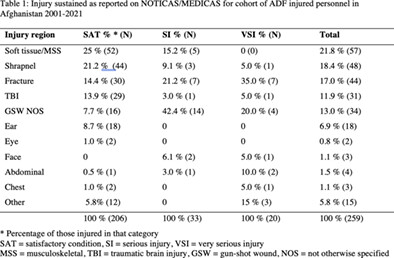
259 ADF personnel were injured in Afghanistan between 2002 and Dec 2021. 20% of these were seriously or very seriously injured, most of whom required surgery (93%) ultimately requiring return to Australia following injury (91%). For those requiring surgery, gun-shot wound was the commonest injuring mechanism (47%) followed by blast injury (39.6%). Orthopaedic (32.2%) and soft tissue initial wound surgery (47.1%) were the commonest surgical procedures.
REVIEW ARTICLES
Planned oesophagectomy after chemoradiotherapy versus salvage oesophagectomy following definitive chemoradiotherapy: a systematic review and meta-analysis
- Pages: 829-839
- First Published: 29 December 2022
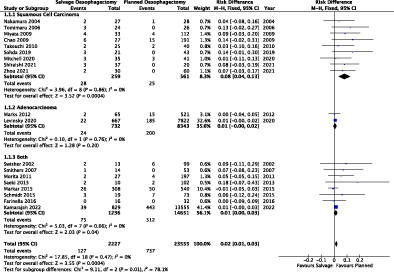
Salvage oesophagectomies have increased rates of rates of postoperative mortality, anastomotic leak, pulmonary complications and decreased rates of R0 margin, which are statistically significant. However, they offer a meaningful chance of long-term survival (at 5 years) for select patients with oesophageal cancer, but the elevated risk of post-operative complications and mortality following salvage oesophagectomy should be recognised.
Percutaneous needle aspiration versus catheter drainage in the management of liver abscess: an updated systematic review and meta-analysis
- Pages: 840-850
- First Published: 26 October 2022
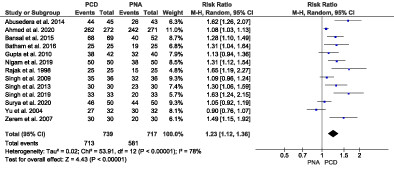
Thirteen trials were included in the comparative analysis of this outcome, with 1456 patients enrolled (739 for PCD and 717 for PNA) [5, 26–28, 30 and 32–39]. Treatment with PCD had a significantly higher success rate than PNA (RR = 1.23; 95% CI [1.12, 1.36], P < 0.00001), but the results were highly heterogeneous across the trials (P < 0.00001, I2 = 78%), and the heterogeneity could not be resolved.
Optimal common limb length in Roux-en-Y gastric bypass surgery: is it important for an ideal outcome? – a systematic review
- Pages: 851-858
- First Published: 08 December 2022
Intraluminal oxygen mitigates acute mesenteric ischaemia: a systematic review of methods and outcomes in animal studies
- Pages: 859-868
- First Published: 20 December 2022
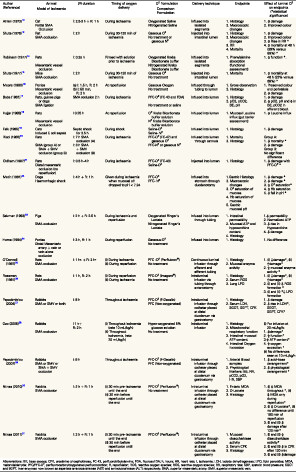
A systematic review of pre-clinical evidence for intraluminal oxygenation in the treatment of intestinal ischaemia. The majority of studies demonstrated a significant benefit. There remain important questions regarding the optimal timing and delivery technique before clinical translation of this treatment strategy.
Management of tenosynovial giant cell tumour of the temporomandibular joint: a systematic review
- Pages: 869-875
- First Published: 14 December 2022

Diffuse type tenosynovial giant cell tumour of the temporomandibular joint (D-TGCT-TMJ) is a rare proliferative disorder. This systematic review showed total resection and arthroplasty are common D-TGCT-TMJ management regimes and patients with D-TGCT-TMJ should be followed up annually for at least five years post-operatively to assess for recurrence.
BREAST SURGERY
Iodine-125 seed versus hook-wire guided breast conserving surgery: do post operative complication rates differ?
- Pages: 876-880
- First Published: 16 February 2023

Radio-guided occult lesion localisation using iodine 125 seeds (ROLLIS), a technique used to localise impalpable breast cancers for breast conserving surgery (BCS). Previous studies have suggested improved efficiency and patient outcomes with ROLLIS compared with hook-wire localisation (HWL). The aim of this report is to compare the post-operative complication rates and safety profiles of ROLLIS versus hook-wire guided surgery.
Breast cancer care and surgery in Australia and New Zealand: compliance of the BreastSurgANZ quality audit with international standards
- Pages: 881-888
- First Published: 01 March 2023
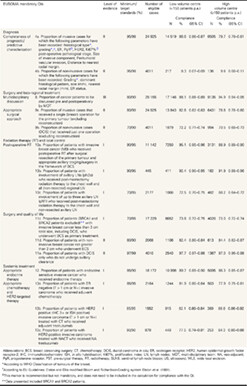
The expression of registry data against a consistent benchmark allows comparison of breast cancer care between countries, to aid identification of inequalities, encourage improvements, and allow re-evaluation of performance after implementation of new guidelines This manuscript presents the compliance of data from the Breast Surgeons of Australia and New Zealand (BreastSurgANZ) Quality Audit (BQA) with the breast cancer care Quality Indicators (QI)s defined by the 2017 European Society of Breast Cancer Specialists (EUSOMA) Guideline for Quality Indicators in Breast Cancer Care. We were able to demonstrate that ANZ surgeons perform at a high standard in discussion of breast cancer patients by multidisciplinary team, and that areas for improvement were in completeness of data capture, and inclusion of genetic syndrome and Ki67% in data collection. We note that due to the rapid evolution of breast cancer treatment, there is need for a contemporary update of QI relating to the use of neoadjuvant and adjuvant systemic therapies.
The use of neoadjuvant systemic therapies in breast cancer in Australia and New Zealand: Breast Surgeons of Australia and New Zealand quality audit
- Pages: 889-895
- First Published: 13 March 2023
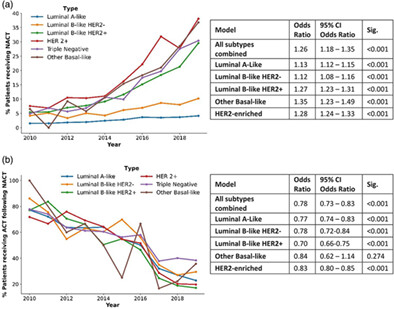
Breast surgeons must maintain contemporary knowledge regarding appropriate referral of breast cancer patients for neoadjuvant chemotherapy (NACT). The 2019 St Gallen International Consensus Guidelines for the primary therapy of early breast cancer and the ASCO Guidelines of 2021 state that NACT is now considered the preferred initial approach in women with stage II–III, triple-negative or HER2 positive breast cancer. This manuscript describes an annual increase in use of NACT, and a corresponding annual decrease in adjuvant chemotherapy in all breast cancer biological subtypes in concordance with an uptake of contemporary guidelines in ANZ, and highlights a need for expansion of BQA data fields related to use of NACT to allow detailed audit of NACT rates in stage II–III TNBC and HER2 enriched BC, and accurate determination of quality of practice in ANZ.
A series of the first 13 combined Magseed and Magtrace cases in a single centre in regional Victoria
- Pages: 896-901
- First Published: 17 March 2023
ENDOCRINE SURGERY
Comparative analysis of pre-operative ultrasound and histopathology in small papillary thyroid carcinoma in the era of active surveillance
- Pages: 902-906
- First Published: 28 February 2023

Comparative analysis of a cohort of patients with papillary cancer less than 15 mm and review of pre-operative ultrasound and histopathological variables to investigate issues arising in the era of active surveillance. We demonstrate a number of surgical candidates who would have been deemed appropriate for active surveillance but have a number of adverse pathological features.
Beware the recurrent ‘benign’ multinodular goitre
- Pages: 907-910
- First Published: 28 February 2023
TRANSPLANTATION SURGERY
Cholangioscopic classification of post-living donor liver transplantation biliary strictures can predict their natural history and response to therapy
- Pages: 911-917
- First Published: 19 October 2022

Addition of cholangioscopy tends to improve stricture cannulation rates at ERCP, and offers a useful classification of post-LDLT strictures with prognostic and therapeutic significance. Type II strictures tend to require more sessions of endotherapy than type I strictures over a longer duration for remodelling.
The impact of perceived donor liver quality on post-transplant outcome
- Pages: 918-925
- First Published: 27 January 2023
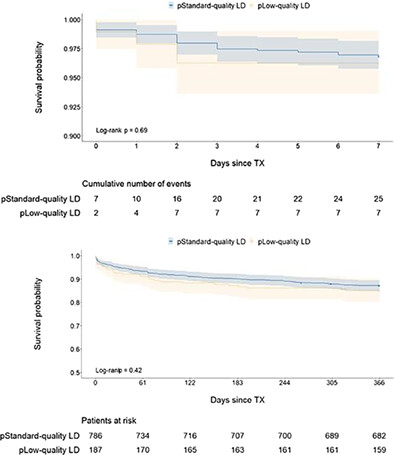
We evaluated the effect of liver donor perceived quality on relisting or recipient death at one-week and one-year after transplantation. Male gende, obesity, donation after cardiac death and alanine aminotransferase values were significantly associated with perceived poor-quality of liver donors. No significant effect of the perceived quality on re-listing or death within the first week and first year post-transplant was observed, adjusting by recipient age and gender, obesity, diabetes, prior liver transplantation and MELD score.
COLORECTAL SURGERY
Perioperative outcomes of emergency and elective colorectal surgery: a bi-institutional study
- Pages: 926-931
- First Published: 06 October 2022
Malignant polyps in the COVID-19 era: a population-based analysis
- Pages: 932-938
- First Published: 24 January 2023
Computed tomographic colonography for symptomatic patients: the diminutive polyp dilemma
- Pages: 939-944
- First Published: 09 November 2022
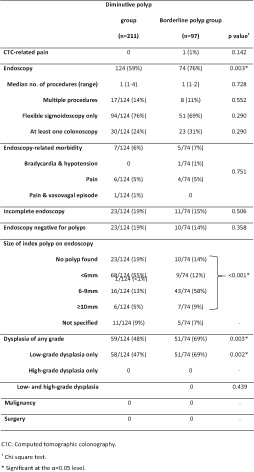
This is a single-centre experience in the radiological detection of diminutive colonic polyps in a cohort of 308 symptomatic patients (211 patients with at least one diminutive (<6 mm) polyp and 97 patients with borderline (6 mm) polyps). We found that most symptomatic patients with diminutive polyps on CT colonography proceed to endoscopy, which frequently confirms dysplasia but which rarely reveals malignancy. In this article, we describe clinical outcomes, and explore approaches to clinical counselling, risk management and joint decision-making.
The effect of primary tumour resection on patients with synchronous metastatic colorectal cancer treated with cetuximab-containing regimens
- Pages: 945-950
- First Published: 19 October 2022
Variation in the length of terminal ileum specimen in right hemicolectomy: a descriptive study
- Pages: 951-955
- First Published: 11 November 2022
Deloyers procedure compared to ileorectal anastomosis as restoration techniques of bowel continuity after extended left colon resection
- Pages: 956-962
- First Published: 05 October 2022
Cost-effectiveness comparison of delayed versus immediate coloanal anastomosis following ultralow anterior resection for rectal cancer
- Pages: 963-969
- First Published: 10 November 2022
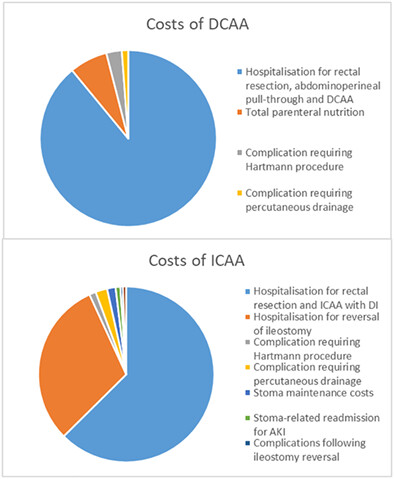
The study compared delayed coloanal anastomosis (DCAA) with immediate coloanal anastomosis (ICAA). DCAA is overall more cost-effective compared to ICAA with DI following ultralow anterior resection. Cost savings should be considered an additional benefit when selecting the DCAA approach for low rectal cancer surgery.
Does intra-operative humidification with warmed CO2 reduce surgical site infection in open colorectal surgery? A randomized control trial
- Pages: 970-979
- First Published: 19 October 2022
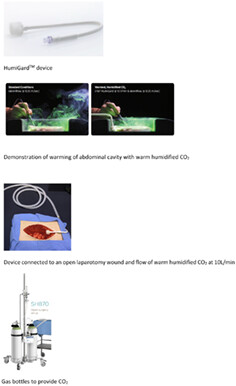
This randomised control trial is an important investigation of a novel method of reducing surgical site infections in colorectal surgery, humidification of the open surgical wound. The present study could not confirm that utilisation of warm, humidified CO2 with HumiGard™ reduces SSI in open colorectal surgery. Further research is indicated to validate and extend these findings.
ORTHOPAEDIC SURGERY
Survival of lateral unicompartmental knee arthroplasty at short-, mid-, and long-term follow-up: a systematic review and meta-analysis
- Pages: 980-988
- First Published: 09 February 2023
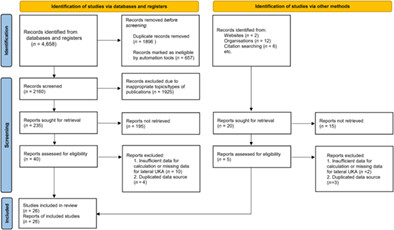
This present study contributes to the current literature by performing a meta-analysis of survival data of lateral UKA alone at short-, mid-, and long-term follow-ups. Twenty-six studies, comprising 5470 lateral UKAs, were incorporated into this analysis. With survivorship defined as the absence of all-cause revisions, pooled results estimated short-to-mid-term (3–5 years) survivorship of 94-96% and demonstrated combined survivorships of 88%, 85%, and 76% at 10, 15, and 25 years following UKA surgeries, respectively.
Post-discharge patient-reported non-adherence to aspirin compared to enoxaparin for venous thromboembolism prophylaxis after hip or knee arthroplasty
- Pages: 989-994
- First Published: 20 January 2023
Assessment of patient satisfaction following revision total knee arthroplasty
- Pages: 995-1000
- First Published: 07 March 2023

We investigated the postoperative satisfaction outcomes of RTKA patients, using a structured telephone assessment questionnaire and review of orthopaedic and hospital records. Strong correlation was found between assessment tools (overall satisfaction, numerical score (0–10), Mahomed Satisfaction Scale). Factors contributing to satisfaction included preoperative ROM, postoperative ROM, Oxford knee score, BMI, and surgical time. These results contribute to the understanding of satisfaction outcomes in RTKA patients, which may assist in appropriately informing patients of expected post-operative outcomes.
Implementation of a relapse prevention program among smokers undergoing arthroplasty: lessons learned
- Pages: 1001-1007
- First Published: 28 February 2023
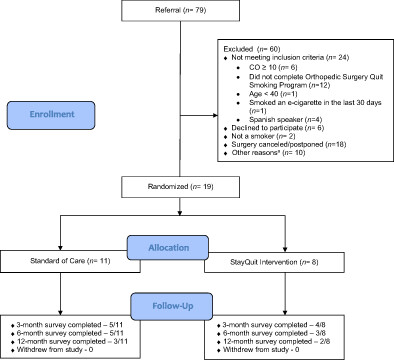
Complications related to surgery or the need for additional surgeries. This work describes a case study describing the recruitment process, study components, and lessons learned from StayQuit, a comprehensive relapse prevention program designed to support patients and prevent relapse after arthroplasty. While we found the intended program, StayQuit, to be unsustainable under current conditions within the orthopedic surgery setting, we examined lessons learned post hoc to determine challenges related to study implementation and recruitment that can help guide similar programs.
PAEDIATRIC SURGERY
Congenital mesoblastic nephroma: review of current management and outcomes in a single centre
- Pages: 1008-1011
- First Published: 16 November 2022
Combined procedures for surgical short bowel syndrome: experience from two European centres
- Pages: 1012-1016
- First Published: 13 December 2022
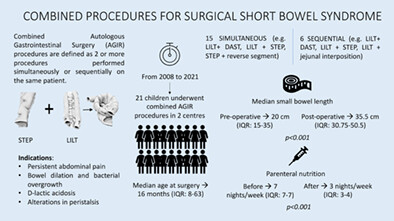
Autologous gastrointestinal reconstructive surgery has become a key component of intestinal rehabilitation programs for Short Bowel Syndrome. The best surgical option remains unknown, and some patients might benefit from more than one technique: we present our experience using combined procedures as primary treatment.
HOW I DO IT
How to perform laparoscopic common bile duct exploration through a transverse choledochotomy
- Pages: 1017-1020
- First Published: 24 February 2023
How to do an enucleation of a branch-duct intraductal papillary and mucinous neoplasm of the head of the pancreas (with video)
- Pages: 1021-1023
- First Published: 07 March 2023
How to do a laparoscopic pancreaticoduodenectomy
- Pages: 1024-1026
- First Published: 24 February 2023
IMAGES FOR SURGEONS
Small bowel resection for ischemia following transcatheter arterial embolization for bleeding jejunal diverticulum: an easily forgotten complication
- Pages: 1027-1028
- First Published: 15 September 2022
68Ga-PSMA PET/CT false positive liver metastasis prior to radical prostatectomy
- Pages: 1029-1030
- First Published: 01 November 2022
Fibroepithelial polyp of the ureter: a prolapsing ureteric mass
- Pages: 1031-1032
- First Published: 19 September 2022
Colonic lipoma: a rare cause of intussusception
- Pages: 1033-1034
- First Published: 22 September 2022
The combination of Chilaiditi syndrome and Bochdalek hernia in an adult: successful management with a robot assisted approach
- Pages: 1035-1037
- First Published: 23 September 2022
Primary repair of traumatic type A aortic dissection
- Pages: 1038-1039
- First Published: 29 September 2022
Pneumoretroperitoneum – is it always an ominous sign?
- Pages: 1040-1041
- First Published: 12 October 2022
Gastrocutaneous fistula caused by mesh migration following diaphragmatic rupture repair
- Pages: 1042-1043
- First Published: 04 October 2022
Two birds, multiple stones – the case of cholecystitis of the double gallbladder and its surgical management
- Pages: 1044-1045
- First Published: 14 October 2022
Foramen of Winslow hernia requiring right hemicolectomy
- Pages: 1046-1047
- First Published: 30 September 2022
Unexpected twist: a case report of asymptomatic synchronous contralateral testicular torsion identified during scrotal exploration
- Pages: 1048-1049
- First Published: 09 October 2022
An incidental infiltrating colonic lesion found during colonoscopy in a woman in her 30s
- Pages: 1050-1051
- First Published: 14 October 2022
Rare case of acute large bowel obstruction secondary to pelvic actinomycosis
- Pages: 1052-1053
- First Published: 08 October 2022
Haematochezia: an atypical presentation of metastatic malignant pleural mesothelioma
- Pages: 1054-1055
- First Published: 05 October 2022
Rare presentation of colitis cystica profunda in a single rectal ulcer
- Pages: 1058-1059
- First Published: 05 October 2022
Massive scrotal cystocoele in a patient with perforated bowel cancer
- Pages: 1060-1061
- First Published: 04 October 2022
Diaphragmatic eventration complicated by gastric volvulus
- Pages: 1064-1066
- First Published: 05 October 2022
Unusual cause of a palpable intra-abdominal mass
- Pages: 1067-1069
- First Published: 13 October 2022
Rectal malignant tumours may have an unexpected histology
- Pages: 1070-1071
- First Published: 27 October 2022
Robotic-assisted deep inferior epigastric perforator (DIEP) flap harvest for breast reconstruction
- Pages: 1072-1074
- First Published: 13 October 2022
Perineal resection for incarcerated rectal prolapse
- Pages: 1075-1076
- First Published: 17 October 2022
Still a challenging diagnosis: perineural spread of head and neck cutaneous SCC and the limitations of MRI imaging
- Pages: 1077-1078
- First Published: 12 October 2022
Gallbladder-associated ectopic liver tissue during cholecystectomy
- Pages: 1079-1081
- First Published: 11 October 2022
Deep Inferior Epigastric Artery (DIEP) anomaly in autologous breast reconstruction
- Pages: 1082-1083
- First Published: 17 October 2022
Perforated small bowel melanoma: primary or metastasis?
- Pages: 1084-1085
- First Published: 19 October 2022
Association to be overlooked: Rasmussen's aneurysm in coexisting lung cancer
- Pages: 1086-1087
- First Published: 20 October 2022
Moynihan's hump of the right hepatic artery: the surgeon's eye cannot recognize what mind doesn't know
- Pages: 1088-1089
- First Published: 14 October 2022
Intralobar lung sequestration: a collaborative approach to an uncommon problem
- Pages: 1090-1092
- First Published: 27 October 2022
A ‘thrill’ in the palm: surgical management of a symptomatic ulnar artery aneurysm
- Pages: 1093-1094
- First Published: 19 October 2022
Severe early aneurysmal degeneration of a Freestyle aortic root bioprosthesis in a patient with known genetic aortopathy
- Pages: 1095-1096
- First Published: 19 October 2022
Malignant recurrence of a tailgut cyst resected 50 years ago
- Pages: 1099-1101
- First Published: 02 November 2022
Gallbladder agenesis: a rare cause of right upper quadrant pain
- Pages: 1102-1103
- First Published: 02 November 2022
Splenic capsulitis associated with gastric GIST
- Pages: 1104-1105
- First Published: 17 November 2022
Pancreaticobiliary maljunction: a rare finding on a routine intra-operative cholangiogram with significant implications
- Pages: 1106-1107
- First Published: 07 November 2022
Giant submucosal haematoma of the intestine complicated by endoscopic submucosal dissection
- Pages: 1108-1109
- First Published: 30 November 2022
Anatomically unusual location of spontaneous retroperitoneal haematoma
- Pages: 1110-1112
- First Published: 14 November 2022
Sarcomatoid transformation of a primary basal cell carcinoma of the cheek
- Pages: 1113-1115
- First Published: 17 November 2022
LETTERS TO THE EDITOR
Red blanket, code crimson, OPSTAT – different names, same process
- Page: 1116
- First Published: 20 January 2023
Extensive recurrent parathyroid carcinoma caused by tumour seeding in endoscopic parathyroidectomy
- Pages: 1117-1118
- First Published: 13 April 2023
ERRATUM
Correction to “Hospital-wide implementation of an electronic-workflow solution aiming to make surgical practice improvement easy”
- Page: 1119
- First Published: 23 March 2023




